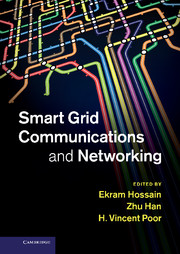Book contents
- Frontmatter
- Contents
- List of contributors
- Preface
- Part I Communication architectures and models for smart grid
- Part II Physical data communications, access, detection, and estimation techniques for smart grid
- Part III Smart grid and wide-area networks
- 9 Networking technologies for wide-area measurement applications
- 10 Wireless networks for smart grid applications
- Part IV Sensor and actuator networks for smart grid
- Part V Security in smart grid communications and networking
- Part VI Field trials and deployments
- Index
10 - Wireless networks for smart grid applications
from Part III - Smart grid and wide-area networks
Published online by Cambridge University Press: 05 January 2013
- Frontmatter
- Contents
- List of contributors
- Preface
- Part I Communication architectures and models for smart grid
- Part II Physical data communications, access, detection, and estimation techniques for smart grid
- Part III Smart grid and wide-area networks
- 9 Networking technologies for wide-area measurement applications
- 10 Wireless networks for smart grid applications
- Part IV Sensor and actuator networks for smart grid
- Part V Security in smart grid communications and networking
- Part VI Field trials and deployments
- Index
Summary
Introduction
By connecting the various entities in the grid and enabling a two-way flow of information related to the production and distribution of energy, communication networks, and more specifically wireless networks, are poised to play a significant role in the modernization of the electric grid. In fact, most functions related to making energy production and consumption more efficient require some form of collecting and sharing information to monitor current usage levels, predict future demands, balance loads, and tightly control the production, distribution, and transmission of power.
While there are many advantages for using wireless networks in the grid, there are many concerns as well. The benefits include providing untethered and universal access to information, and deploying and maintaining infrastructure easily and at low cost. Drawbacks are mostly related to signal propagation properties in what could be a noisy environment and are inherent to the use of a shared medium, which may be prone to interference.
This chapter discusses the use of wireless networks in the context of the smart grid. First, it provides an overview of the various applications envisaged in the smart grid and discusses their communication requirements. Sifting through thousands of communication requirements leads to an identification of different classes of applications based on their traffic and quality-of-service (QoS) requirements as well as an identification of the communication actors and their logical topologies. Subsequently, there is a discussion of the main factors to consider in designing and deploying wireless networks, including spectrum, coverage, resilience, and security.
Information
- Type
- Chapter
- Information
- Smart Grid Communications and Networking , pp. 234 - 262Publisher: Cambridge University PressPrint publication year: 2012
Accessibility standard: Unknown
Why this information is here
This section outlines the accessibility features of this content - including support for screen readers, full keyboard navigation and high-contrast display options. This may not be relevant for you.Accessibility Information
- 3
- Cited by
